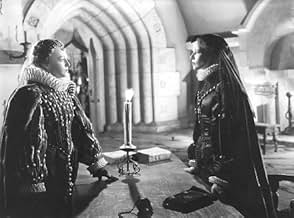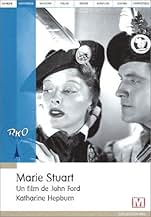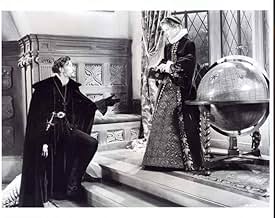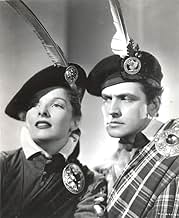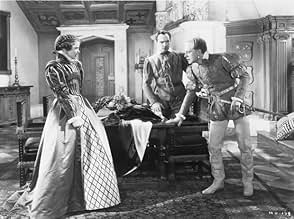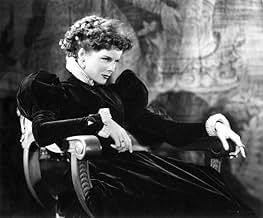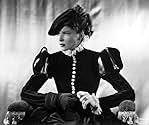IMDb RATING
6.3/10
2.9K
YOUR RATING
The recently widowed Mary Stuart returns to Scotland to reclaim her throne but is opposed by her half-brother and her own Scottish lords.The recently widowed Mary Stuart returns to Scotland to reclaim her throne but is opposed by her half-brother and her own Scottish lords.The recently widowed Mary Stuart returns to Scotland to reclaim her throne but is opposed by her half-brother and her own Scottish lords.
- Directors
- Writers
- Stars
- Awards
- 3 wins & 1 nomination total
- Directors
- Writers
- All cast & crew
- Production, box office & more at IMDbPro
Featured reviews
Katharine Hepburn plays the young queen in this John Ford version of the rivalry between Mary of Scots and her cousin, Elizabeth I (played by Florence Eldridge; whose husband Fredric March plays a jaunty Lord Bothwell). Cut back to the bare bones, and squarely on the differences between the two women, it isn't altogether successful.
John Knox rants his Protestant spiel, Bothwell appears with a retinue of pipers (at several points); Darnley's murder is glossed over, as is his smallpox. John Carradine has a well-defined role as the ill-fated David Rizzio, while Mary's parasitical court of Lords are quirkily represented and dismissed.
Hepburn isn't as bad as one would fear, but it wasn't really a suitable role for her, nor, one would expect, was the material enough for tough director Ford to make much of. So this film remains a misfire, with some interesting sequences and some strong performances, but as a whole, it just doesn't work.
John Knox rants his Protestant spiel, Bothwell appears with a retinue of pipers (at several points); Darnley's murder is glossed over, as is his smallpox. John Carradine has a well-defined role as the ill-fated David Rizzio, while Mary's parasitical court of Lords are quirkily represented and dismissed.
Hepburn isn't as bad as one would fear, but it wasn't really a suitable role for her, nor, one would expect, was the material enough for tough director Ford to make much of. So this film remains a misfire, with some interesting sequences and some strong performances, but as a whole, it just doesn't work.
The complicated historical background involved in MARY OF Scotland is such that unless you know something about British monarchs you'll have a hard time knowing where the truth lies in this epic historical romance. But it's clear that KATHARINE HEPBURN gives a radiant performance as Mary, Queen of Scots--the only drawback being that she never ages a bit over a twenty-five year span. When she goes to her execution, she looks just as young as she did in the opening scene.
It's a pleasure to report that FREDRIC MARCH breathes a lot of life into his portrayal of Bothwell. Too bad he didn't exhibit this kind of gusto when he played the title role in ANTHONY ADVERSE the same year. He's all bravado and robust athletic grace and looks good in his period costumes. Maybe we owe his strong performance to John Ford, but whatever it is, he's much better here than he was as Anthony Adverse.
JOHN CARRADINE seemed an unusual choice to play Rizzo, the Italian secretary who happens to be a troubadour of sorts, but it's nice to see him in a more sympathetic role for a change. DONALD CRISP, ALAN MOBRAY, DOUGLAS WALTON and FRIEDA INESCOURT are interesting in supporting roles.
Walton is another actor who shines here, rather than remaining colorless in the background of many a film. He gives a flamboyant performance as Lord Darnley and it's probably among the best roles he ever had.
FLORENCE ELDRIDGE makes an interesting Queen Elizabeth, less showy in the role than Bette Davis or Flora Robson but still with the right amount of regal spirit.
John Ford directs the first half of the film with his usual authority but things get a little too repetitious and slow-moving in the second half when tedium really settles in before Mary's final walk to the execution block.
Summing up: A mixed bag, some strong performances, a few strong scenes but overall result is disappointing. Here's an historical romance that cried out for Technicolor. It manages to look drab in B&W despite the lavish costumes and good photography.
It's a pleasure to report that FREDRIC MARCH breathes a lot of life into his portrayal of Bothwell. Too bad he didn't exhibit this kind of gusto when he played the title role in ANTHONY ADVERSE the same year. He's all bravado and robust athletic grace and looks good in his period costumes. Maybe we owe his strong performance to John Ford, but whatever it is, he's much better here than he was as Anthony Adverse.
JOHN CARRADINE seemed an unusual choice to play Rizzo, the Italian secretary who happens to be a troubadour of sorts, but it's nice to see him in a more sympathetic role for a change. DONALD CRISP, ALAN MOBRAY, DOUGLAS WALTON and FRIEDA INESCOURT are interesting in supporting roles.
Walton is another actor who shines here, rather than remaining colorless in the background of many a film. He gives a flamboyant performance as Lord Darnley and it's probably among the best roles he ever had.
FLORENCE ELDRIDGE makes an interesting Queen Elizabeth, less showy in the role than Bette Davis or Flora Robson but still with the right amount of regal spirit.
John Ford directs the first half of the film with his usual authority but things get a little too repetitious and slow-moving in the second half when tedium really settles in before Mary's final walk to the execution block.
Summing up: A mixed bag, some strong performances, a few strong scenes but overall result is disappointing. Here's an historical romance that cried out for Technicolor. It manages to look drab in B&W despite the lavish costumes and good photography.
There was something of a fad for Tudor-period dramas in the late 1930s, although Mary of Scotland is something of an overlooked picture in the careers of Katherine Hepburn and John Ford. The star and director went on to have an on-off love affair, although this was the only occasion on which they worked together.
Mary of Scotland has the look that is typical of Ford's RKO features. It's often forgotten that Ford was a director who liked to work with space, shape and light, usually manifested in a sharp contrast between the indoor and outdoor worlds. Here the contrast is between the palace of Elizabeth – light, open and filled of straight lines and symmetry – and the castle of Mary – small, shadowy and made of rough curves. At first glance this seems to imply that the Scottish setting is grimmer and more confined, but for Ford these cosy spaces with layers of shadows were also about honesty and simplicity – see for example the compositions he makes in The Informer or The Fugitive. Those two pictures were also made at RKO, and their expressive look is testament to the fact that although the studio might not have had much money it did have a strong and open-minded production design team, something Ford took advantage of when he could.
By this point, few Ford films would be complete without the sing-song scene, and there is an especially fine example in Mary of Scotland. Ford never made an out-and-out musical in his career, but the way he uses singing as an emotional backdrop is remarkable. Here, the song sung by the peasants as they march into the castle begins as a simple yet effective expository device – demonstrating where the people's loyalties lie – but then the scene moves onto another level. Ford isolates one singer, then cuts to a rare close-up of Hepburn. The beauty of the music provides a backdrop to her emoting. It is in such moments that Ford's direction is at its strongest.
This was perhaps an important breakthrough role for Hepburn, whose parts until now had mostly been as teenagers or young women. This is her first real adult role and she handles it well, albeit with one or two touches of uncertainty when she is required to act "queenly". She does however manage the task of humanising the queen, more so than the screenplay would seem to allow. Unfortunately her leading man, the normally excellent Fredric March, is rather bland here. It's a real treat though to see John Carradine in a role where he really gets to show his more sensitive side. Because of his looks, not to mention his creepy voice, the character actor generally landed villainous roles, but he was actually at his best playing good guys.
One oft-repeated story regarding this production – although it varies a little depending on who's telling it, so pinches of salt at the ready – is that Hepburn and Ford disagreed over the necessity of Mary and Bothwell's final scene together on the tower top. Ford thought it a pointless bit of soppiness, Hepburn said it was the most important scene in the script. Eventually a flippant Ford challenged Hepburn to direct it herself, which she did. The scene stands out because Hepburn actually shoots it with some romantic tenderness – something Ford hardly ever did – with lengthy close-ups and rhyming angles. You can see why Ford didn't like it; he tended to downplay the love themes in his pictures, and on top of that the scene is rather heavy on dialogue. Hepburn was right though – without this scene the romance between Mary and Bothwell would be little more than a subplot, and without the romance the film wouldn't work. Audiences would find it hard to empathise with a queen clinging onto her throne, but easy to sympathise with a woman separated from the man she loves.
Mary of Scotland was not really Ford's cup of tea, and it was his rather cavalier approach to interpreting a screenplay that spoiled a fair few of his pictures (even though it won him the admiration of the auteurists). This picture is only saved by his use of music, the proficiency of the RKO crew and of course the good judgement of Katherine Hepburn. Nevertheless, I can't help but love Ford's laid-back realism. In one scene, we see a dog barking crazily at men entering a room; in another a moth flutters about John Knox's head. How many other directors of that era would have kept those takes?
Mary of Scotland has the look that is typical of Ford's RKO features. It's often forgotten that Ford was a director who liked to work with space, shape and light, usually manifested in a sharp contrast between the indoor and outdoor worlds. Here the contrast is between the palace of Elizabeth – light, open and filled of straight lines and symmetry – and the castle of Mary – small, shadowy and made of rough curves. At first glance this seems to imply that the Scottish setting is grimmer and more confined, but for Ford these cosy spaces with layers of shadows were also about honesty and simplicity – see for example the compositions he makes in The Informer or The Fugitive. Those two pictures were also made at RKO, and their expressive look is testament to the fact that although the studio might not have had much money it did have a strong and open-minded production design team, something Ford took advantage of when he could.
By this point, few Ford films would be complete without the sing-song scene, and there is an especially fine example in Mary of Scotland. Ford never made an out-and-out musical in his career, but the way he uses singing as an emotional backdrop is remarkable. Here, the song sung by the peasants as they march into the castle begins as a simple yet effective expository device – demonstrating where the people's loyalties lie – but then the scene moves onto another level. Ford isolates one singer, then cuts to a rare close-up of Hepburn. The beauty of the music provides a backdrop to her emoting. It is in such moments that Ford's direction is at its strongest.
This was perhaps an important breakthrough role for Hepburn, whose parts until now had mostly been as teenagers or young women. This is her first real adult role and she handles it well, albeit with one or two touches of uncertainty when she is required to act "queenly". She does however manage the task of humanising the queen, more so than the screenplay would seem to allow. Unfortunately her leading man, the normally excellent Fredric March, is rather bland here. It's a real treat though to see John Carradine in a role where he really gets to show his more sensitive side. Because of his looks, not to mention his creepy voice, the character actor generally landed villainous roles, but he was actually at his best playing good guys.
One oft-repeated story regarding this production – although it varies a little depending on who's telling it, so pinches of salt at the ready – is that Hepburn and Ford disagreed over the necessity of Mary and Bothwell's final scene together on the tower top. Ford thought it a pointless bit of soppiness, Hepburn said it was the most important scene in the script. Eventually a flippant Ford challenged Hepburn to direct it herself, which she did. The scene stands out because Hepburn actually shoots it with some romantic tenderness – something Ford hardly ever did – with lengthy close-ups and rhyming angles. You can see why Ford didn't like it; he tended to downplay the love themes in his pictures, and on top of that the scene is rather heavy on dialogue. Hepburn was right though – without this scene the romance between Mary and Bothwell would be little more than a subplot, and without the romance the film wouldn't work. Audiences would find it hard to empathise with a queen clinging onto her throne, but easy to sympathise with a woman separated from the man she loves.
Mary of Scotland was not really Ford's cup of tea, and it was his rather cavalier approach to interpreting a screenplay that spoiled a fair few of his pictures (even though it won him the admiration of the auteurists). This picture is only saved by his use of music, the proficiency of the RKO crew and of course the good judgement of Katherine Hepburn. Nevertheless, I can't help but love Ford's laid-back realism. In one scene, we see a dog barking crazily at men entering a room; in another a moth flutters about John Knox's head. How many other directors of that era would have kept those takes?
The directors cannot refrain from showing the two queens together in one scene.Charles Jarrot -whose movie is inferior to John Ford's- did the same in 1972.And however,they never met ,not a single time during Mary's captivity.But John Ford's scene is useful for people who know little about the Virgin Queen.It's sure that Mary's childhood in France was a nice one even though her reign was short as king François II's wife.On the other hand,Elizabeth lived in fear when she was a child for her bloody sister wanted to get rid of her.
The first past begins in Scotland ,and France is only evoked in Mary's memories.This first part is the most satisfying historically speaking:Darnley's and Ricci's murders are well directed by Ford,and the town criers who ,every ten minutes announce "It's eight'o clock!All is fine!" shows his sense of humor.Biggest flaw is the little part of James Stuart, aka"the bastard" aka Maurey:This man is really the stringman,who plays a prominent part in the queen's downfall,holding Mary like a puppet on a string,travelling to France when rebellion begins -he was not here when Mary was imprisoned in Lochleven-,just coming back to reap the benefits (regency he had lost when his sister came back).
Frederic March is a fine actor,but his Bothwell is not credible.Bothwell was a hairy brute ,not the romantic chivalrous fair knight we see here.Mary's abduction remains a mysterious part because the historians have no documents of what really happened.Mary's captivity in Lochleven-where she at last understood how James Stuart fooled her -and her extraordinary escape -worthy of Hitchcock's suspense-lasts barely 30 seconds on the screen.
Ditto for Mary's captivity in England.When she arrived,she was in what we would call "under house arrest" today.Only during her last year,when they discovered a plot,she was taken to the fortress of Fotheringay (a wonderful Fairport Convention song by the way),she was really a prisoner in the modern sense of the term.And she had a whole floor for herself though.
The trial is unsatisfying.At the time,Mary did not care for Bothwell anymore,she was longing to become a martyr of the Catholic cause.She did not know that the pope did not take her seriously .The scene with Donald is pure romantic fiction.
All in all ,and even if the things fall apart a bit in the second part,the movie is magnificently enhanced by Hepburn's presence and Ford -they said they had a love affair on the set- lovingly films her.I've been told that the scene between Bothwell and the queen on the tower was filmed by KH herself.
The first past begins in Scotland ,and France is only evoked in Mary's memories.This first part is the most satisfying historically speaking:Darnley's and Ricci's murders are well directed by Ford,and the town criers who ,every ten minutes announce "It's eight'o clock!All is fine!" shows his sense of humor.Biggest flaw is the little part of James Stuart, aka"the bastard" aka Maurey:This man is really the stringman,who plays a prominent part in the queen's downfall,holding Mary like a puppet on a string,travelling to France when rebellion begins -he was not here when Mary was imprisoned in Lochleven-,just coming back to reap the benefits (regency he had lost when his sister came back).
Frederic March is a fine actor,but his Bothwell is not credible.Bothwell was a hairy brute ,not the romantic chivalrous fair knight we see here.Mary's abduction remains a mysterious part because the historians have no documents of what really happened.Mary's captivity in Lochleven-where she at last understood how James Stuart fooled her -and her extraordinary escape -worthy of Hitchcock's suspense-lasts barely 30 seconds on the screen.
Ditto for Mary's captivity in England.When she arrived,she was in what we would call "under house arrest" today.Only during her last year,when they discovered a plot,she was taken to the fortress of Fotheringay (a wonderful Fairport Convention song by the way),she was really a prisoner in the modern sense of the term.And she had a whole floor for herself though.
The trial is unsatisfying.At the time,Mary did not care for Bothwell anymore,she was longing to become a martyr of the Catholic cause.She did not know that the pope did not take her seriously .The scene with Donald is pure romantic fiction.
All in all ,and even if the things fall apart a bit in the second part,the movie is magnificently enhanced by Hepburn's presence and Ford -they said they had a love affair on the set- lovingly films her.I've been told that the scene between Bothwell and the queen on the tower was filmed by KH herself.
The life story of Mary, Queen of Scots is a thoroughly engaging one. I recommend anyone who wants to know more about the history while being entertained at the same time to check out the two Jean Plaidy books, ROYAL ROAD TO FOTHERINGAY and its sequel, THE CAPTIVE QUEEN OF SCOTS - two great little novels that tell you all there is to know.
MARY OF Scotland is an all-too Hollywoodised version of the story that suffers from an exceptionally overlong running time, unfortunately. It's strange, because some parts of the production are exceptionally slow and boring, while 19 years of history is condensed into about five minutes. There are a few eventful bits but for the most part this is a drag.
The director is none other than John Ford, but despite the presence of such a cinematic luminary, he seems uninterested in the material which is lifeless as a result. Katharine Hepburn is also a disappointment as Mary herself, singularly failing to make the queen sympathetic in any way. Fredric March does what he can as Bothwell, and there are nice little roles for John Carradine and Moroni Olsen, but it's not enough.
I particularly disliked the way that some good little bits of history are omitted or simplified for no apparent reason. For instance, Douglas Walton's final scene didn't happen that way at all and much more drama could have been made of it. Instead all the focus is on the talk and its incessant and goes nowhere. The definitive story of Mary, Queen of Scots this certainly isn't.
MARY OF Scotland is an all-too Hollywoodised version of the story that suffers from an exceptionally overlong running time, unfortunately. It's strange, because some parts of the production are exceptionally slow and boring, while 19 years of history is condensed into about five minutes. There are a few eventful bits but for the most part this is a drag.
The director is none other than John Ford, but despite the presence of such a cinematic luminary, he seems uninterested in the material which is lifeless as a result. Katharine Hepburn is also a disappointment as Mary herself, singularly failing to make the queen sympathetic in any way. Fredric March does what he can as Bothwell, and there are nice little roles for John Carradine and Moroni Olsen, but it's not enough.
I particularly disliked the way that some good little bits of history are omitted or simplified for no apparent reason. For instance, Douglas Walton's final scene didn't happen that way at all and much more drama could have been made of it. Instead all the focus is on the talk and its incessant and goes nowhere. The definitive story of Mary, Queen of Scots this certainly isn't.
Did you know
- TriviaKatharine Hepburn credited John Ford with saving her life one day on the set. They were shooting a scene of Hepburn on horseback when the horse she was riding kept going unexpectedly. Ford yelled at Hepburn to duck just before she was about to collide with a low branch.
- GoofsMary's execution takes place outdoors. It actually took place in the great hall of Fotheringay Castle.
- Quotes
Mary, Queen of Scots: [to Queen Elizabeth I] I might have known you'd come to gloat like this - stealthily, under cover of night.
- Crazy creditsOpening credits: "Like two fateful stars, Mary Stuart and Elizabeth Tudor appeared in the sixteenth century, to reign over two great nations in the making ... They were doomed to a life-and-death struggle for supremacy, a lurid struggle that still shines across the pages of history ... But today, after more than three centuries, they sleep side by side, at peace, in Westminster Abbey."
ENGLAND
- Alternate versionsExists in a computer-colorized version.
- ConnectionsFeatured in The Costume Designer (1950)
Details
- Release date
- Country of origin
- Language
- Also known as
- María Estuardo, reina de Escocia
- Filming locations
- Production company
- See more company credits at IMDbPro
- Runtime
- 2h 3m(123 min)
- Color
- Aspect ratio
- 1.37 : 1
Contribute to this page
Suggest an edit or add missing content


